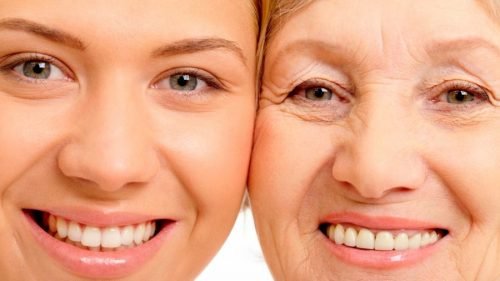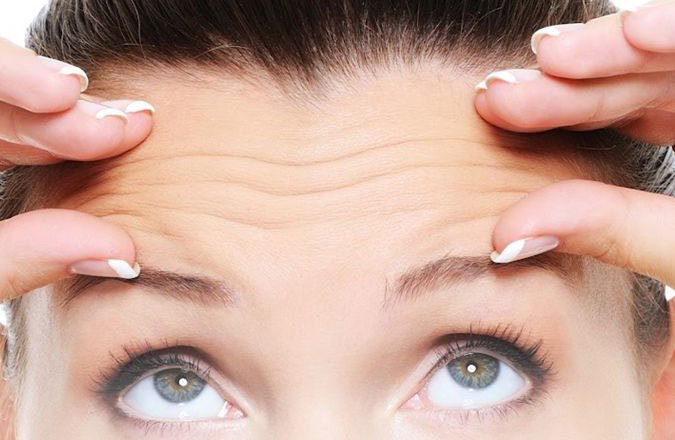Skin ageing
The skin is the body’s largest organ, as well as its only external organ, so it is only natural for the skin to be the first place to show our age. A person’s rate of skin ageing differs significantly among different populations, and different parts of a single person’s skin can vary in its ageing. Age-related skin changes are inevitable, and although we cannot stop the process of ageing, we CAN create good skincare routines and make healthy lifestyle choices to minimise the signs of ageing.
Influences to ageing
The factors that contribute to the skin’s ageing process are divided into two categories, intrinsic and extrinsic. The natural ageing process is called intrinsic ageing, or genetic ageing, and there is not a lot we can do to combat this process. Extrinsic ageing, however, is caused by environmental factors that are often within our control, which means we can fight them and slow down our skin’s ageing.
Intrinsic ageing – how we age, naturally
So, what exactly happens internally to cause our skin to show its age?
Intrinsic biochemical changes occur as a natural consequence of ageing and are determined by genes. Our genes influence things such as our skin colour, skin type (normal, dry, oily), pore size and cellular activities. This continuous process of aging normally begins in our mid-twenties but the signs are typically not visible until our late 30s or early 40s. The two key factors of intrinsic ageing are hormones and cellular recession, which drive the biochemical events that occur in our bodies.
Hormonal and cellular recession factors of skin ageing
- Reduced production of collagen, elastin and glycosaminoglycans (GAGs), so skin loses its tensile strength
- Reduction in the skin’s ability to bind water, resulting in skin dehydration
- Reduced lipid production, so the skin becomes dry and its barrier function is weakened
- Slower blood flow, so nutrients are less efficiently delivered to the skin’s cells
- Slower desquamation means skin cells take longer to shed and regenerate
- Impaired immune function
- Formation of senescent cells (ageing cells)These ongoing biochemical changes, which vary from person to person and across an individual’s life, lead to the physical signs that we see in our bodies.
Physical signs of skin ageing
- Lines and wrinkles
- Sagging or loose skin
- Lack of elasticity and firmness
- Thinner skin
- Lack of fat in subcutaneous layer, which causes wrinkles because there is less ‘cushion’ to support the dermis
- Rough skin texture
- Age spots (skin discoloration)
- Uneven skin tone
- Dull, lacklustre skin
- Dilated capillaries (redness)

So now we know about the intrinsic factors that we can’t change. What about the ones we can?
Extrinsic ageing – how we age, faster
The intrinsic rate of skin ageing in any individual can be dramatically influenced by personal and environmental factors, such as sun exposure, smoking, alcohol consumption and lifestyle. The extrinsic factor that has the greatest impact on our skin is our exposure to ultraviolet light, so we’ll talk about that first.
UV exposure
UV radiation is composed of UVA, UVB and UVC and among them, UVB radiation is most responsible for photoaging as it penetrates shallower than UVA. UVB is absorbed mainly in the epidermis by keratinocytes and melanocytes and causes damage to DNA strands. UV radiation changes the activity of our skin cells by stimulating the chemical messengers to signal the melanocytes to produce more melanin to protect skin cells against UV damage. Overexposure to the sun causes an accumulation of melanin in the epidermis, which creates the pigmentation we know as freckles and age spots.
These chemical messengers also stimulate other chemicals and enzymes to break down collagen and elastin fibres, which impairs the synthesis of new collagen and leads to a loss of skin strength and elasticity.
So, the take-home message? Yes, the same thing your mother told you as a child – protect your skin from the sun!
Smoking
The next biggest extrinsic factor that accelerates our skin ageing is smoking, and naturally, the more years you smoke, the more it will show on your skin.
Smoking is strongly associated with skin ageing in both sexes and causes skin damage primarily by decreasing blood flow to the skin, which in turn deprives our skin tissues of oxygen and nutrients. Smokers have fewer collagen and elastin fibres in the dermis, which causes the skin to become slack, rough, and less elastic.
Research has found that smoking has a strong effect on skin ageing, even in people who protect their skin from sun exposure. So, even though smoking is second on our list here, it’s still a huge factor in skin ageing.
Alcohol consumption
We all know that heavy alcohol consumption causes dehydration, however, most of us don’t realise that our skin suffers the most from dehydration. The affected liver function also impairs our vitamin A production, which in turn affects the skin. Drinking alcohol also causes dilation of the blood vessels in the skin, which can make the skin appear blotchy and uneven, which may become permanent with excessive drinking over many years.
Diet
Eating plenty of fresh fruits and vegetables is a simple recipe for healthy skin, as this gives our skin its required vitamins, antioxidants and hydration. Overeating sugar can make the skin dull and wrinkled because the sugar in our blood attaches to proteins and makes new harmful molecules called glycation. Glycations damage other proteins like collagen and elastin, which leads to sagging.
Sleep and stress
We’ve all seen bags under our eyes when we don’t get enough sleep, so it should be no surprise that sleep affects the health and vitality of our skin. Lack of sleep makes our bodies release the hormone called cortisol, and excess cortisol can break down collagen and elastin, which those key factors in healthy skin. Missing out on proper sleep also decreases our body’s production of growth hormones, which are vital for cell growth and our skin’s natural regeneration abilities.
Too much stress is often connected with lack of sleep, and both these factors have similar effects on our skin. Cortisol, otherwise known as the stress hormone, is released into the body in times of stress, and over the long term, it can seriously harm our skin cells.
How to combat ageing?
Has this list of ways we harm our skin left you feeling hopeless? Don’t despair! You don’t have to live like a Puritan to keep your skin looking younger. Here is a list of the most effective things you can do to minimise skin ageing:
- Create a daily skincare routine
- Use well-researched and clinician-recommended products
- Wash your face twice a day and after sweating heavily
- Cleanse your skin gently; avoiding scrubbing
- Protect your skin from the sun EVERDAY, even if it’s cloudy
- Wear sunglasses on sunny days to prevent squinting lines
- Apply self-tanner rather than going to Solariums
- Eat a healthy, well-balanced diet
- Stop smoking
- Drink less alcohol
- Exercise 3-5 times a week
Treatments to combat and reduce the signs of ageing:
Even if we live a skin-friendly and healthy life, natural skin ageing will occur. That’s where we come in. At Medix Skincare, we can recommend and provide a range of treatments, depending on your skin. These are the treatments we recommend considering, as they are effective and safe:
Laser/IPL/VPL treatments
Light source treatments such as laser, intense pulsed light (IPL) or variable pulsed light (VPL) are the safest and most effective treatment options for reducing signs of ageing. They use bursts of light energy to heat the epidermis and dermis, stimulating collagen production and improving skin tone and texture, which simultaneously smooths skin discolouration.
Chemical peel
Peels are used to exfoliate the top layer, causing dead skin cells to peel off and new, tighter skin forms, as collagen production is stimulated in response to that. Safe chemical peels use glycolic acid, lactic acid or salicylic acid. Peels can help reduce fine lines, fade small scars, and improve sun-damaged and discoloured areas. And the stronger the peel, the more dramatic and longer-lasting the results.
HydraFacial
HydraFacial treatment removes dead skin cells and impurities and simultaneously bathes the underlying skin with active serums that cleanse, exfoliate, rejuvenate and hydrate the skin, refining skin tone and texture. The HydraFacial stimulates the growth of new skin cells, without requiring any downtime. This treatment has a myriad of great effects, such as targeting fine lines and wrinkles, removing pore congestion, minimising pore size, and helping the skin heal itself from sun damage and hyperpigmentation.
Radiofrequency microneedling (RF needling)
Radiofrequency Microneedling technology uses a matrix of 49 (7×7) gold-coated insulated micro-needles, which carefully pierce the dermis to release localised energy, without releasing any potentially damaging heat into the outer skin layer, the epidermis. The radiofrequency affects the dermis by activating collagen and elastin production. The insertions of tiny needles into the skin stimulate the skin’s wound healing response, inducing growth factor secretion and fibroblast production, which naturally tightens the skin’s surface and strengthens the underlying deep connective tissue.
Radiofrequency microneedling has been shown by research to tighten and rejuvenate the skin and improve skin laxity, which makes it an excellent solution for ageing skin.
So we conclude…
While this has been a lot of information about your skin and the ageing process, we hope you feel empowered with the knowledge you need to combat skin ageing.
The clinicians at Medix Skincare are always happy to talk to you about treatments to help keep your skin looking young, healthy and vibrant.
At Medix Clinic, we offer a comprehensive range of professional skin and cosmetic treatments in Melbourne, tailored to your unique needs. Our services include effective acne scarring treatment in Melbourne, advanced scar treatment in Melbourne, and cutting-edge radio frequency microneedling in Melbourne to stimulate skin repair and regeneration. We also specialise in skin needling in Melbourne, non-surgical skin tightening in Melbourne, and safe skin tag and mole removal in Melbourne.
For pigmentation concerns, we provide precise pigmentation removal in Melbourne, helping you achieve a more even skin tone. To restore your skin’s natural radiance, our expert skin rejuvenation treatments in Melbourne are designed to revitalise and refresh. Additionally, enhance your smile with our professional LED teeth whitening in Melbourne, delivering safe and noticeable results.
At Medix, our goal is to deliver visible outcomes using evidence-based technologies, ensuring you feel confident in your skin.
Elham
Clinic manager
Book Your Appointment



